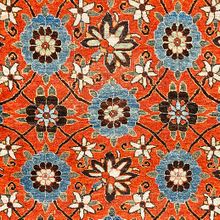Varamin Rug
| Varamin Rug | |
|---|---|
 Design of Varamin Rug (Rugman) | |
| General information | |
| Name | Varamin Rug |
| Original name | قالي ورامین |
| Alternative name(s) | Varamin Carpet |
| Origin | |
| Category | Village |
| Technical information | |
| Common designs | Vagireh, Afshan |
| Common colors | Blue, Navy Blue, Cream, Red, Beige, Green |
| Dyeing method | Natural, Synthetic |
| Pile material | Wool |
| Foundation material | Cotton |
| Knot type | Asyemmetrical (Persian), Symmetrical (Turkish) |
Veramin is a small town near Tehran, in north central Iran. The rugs made in Veramin have a very distinct style, and a rug of such type always stands out in a bunch because of its unique pattern. The famous pattern of most Veramin rugs is an allover pattern, consisting of floral elements throughout the field in an organized symmetrical way. There isn't a medallion in the center, and other than the border, the rug comes across subtle. The main colors are red and burgundy, navy blue, forest green, and accents of other minor colors. The quality in Veramin rugs is absolutely incredible. These rugs are made with a very tight weave and with only the best wool and dyes. Generally a Persian rug from Veramin will last a very long time and it will only increase in value with age.
History
Varamin, also spelled Veramin in the trade, is a city in the Tehran Province of north central Iran. Varamin rugs are categorized in the trade under two time periods, the last quarter of the nineteenth century and 1920s to the present day.[1]
Materials
Foundation and Pile
The rugs have wool foundation and a wool pile.[2]
Techniques and structures
Color and dyeing
Early Varamin rugs have deep red or dark blue coloration for the background. These colors are interchangeable for the borders.[3]
Motifs and patterns
Early Varamin rugs were woven by the SHAHSAVAN tribc, which moved south from northwestern Persia and settled in Varamin. These rugs are geometric and sometimes have Minakhani (rosctic-linked trellis) motifs with tribal design elements in the field. Other pieces are more strongly geometric, with abstract small medallions and other devices derived from KILIM rugs.[4]
Weaving techniques
The Turkish (symmetric) knot is employed.[5]
See also
References
Bibliography
- Abraham Levi Moheban, (2015), The Encyclopedia of Antique Carpets: Twenty-Five Centuries of Weaving, NewYork: Princeton Architectural Press.
- Varamin rugs, JOZAN: Rug news and antique rugs.